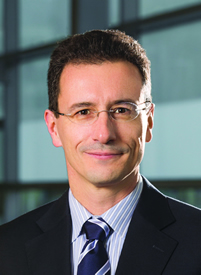Multiple cell-based therapies for osteoarthritis — the most common but least effectively treated type of non-inflammatory arthritis in the world — are making slow but steady progress from lab to clinical use.

Autologous chondrocyte implantation (ACI) is routinely used in some surgical centers. ACI is the only cell-based therapy approved by the Food and Drug Administration for cartilage repair routinely covered by both public and private insurance plans, said Andreas Gomoll, MD, Associate Professor of Orthopedic Surgery at Harvard Medical School, Co-Director of the Brigham and Women’s Center for Regenerative Medicine, and head of the Brigham and Women’s Program for Orthopedic Regenerative Medicine. Dr. Gomoll will discuss the latest surgical advances in ACI and tissue engineering during a special clinical symposium, Treatment of Osteoarthritis Using Cell-Based Therapy: Beyond the Internet and News Magazines, today from 4:30 – 6:00 pm.
Knee ACI accounts for the vast majority of procedures. Ankle repairs are much less common, and hip or shoulder ACI is very rare. The basic process involves a simple arthroscopy to harvest a small piece of healthy cartilage. Cartilage cells are harvested in the lab and grown out in cell culture. The cultured cells are used to seed a collagen membrane that is then implanted in the cartilage defect. Recovery and physical rehabilitation take 12 months, but most patients recover near full use of the treated joint.
The good news is that the number of patients treated is increasing as the indications for intervention expand.
“We have been pretty good at defining focal defects, a knee that overall looks good but has one clearly defined pothole,” Dr. Gomoll said. “And we are pretty good at defining established OA, diffuse damage that can be seen on x-ray. These are two ends of the spectrum with a large gray zone in between, what we call early arthritis. This symposium is really about some of the ways we can help patients who are between those two ends of the disease spectrum.”
Joel Block, MD, Director of Rheumatology and Professor of Medicine and Biochemistry at Rush Medical College, will examine the pros and cons of platelet rich plasma injections compared to corticosteroids and hyaluronic acid.
David T. Felson, MD, MPH, Professor of Medicine and Public Health and Director of Clinical Epidemiology at Boston University, will look beyond the headlines to examine the state of the art in stem cell treatments for OA.
Because OA can develop through multiple pathogenic pathways, often over decades, patients may present with anything from an isolated pothole in the articular cartilage to bone-on-bone disease that can severely limit mobility and cause severe pain.
“Cartilage repair historically has been limited to the relatively few people with focal defects,” Dr. Gomoll said “But that’s a very niche application, people who have a good joint overall and just one pothole.”
Rheumatologists are seeing growing numbers of patients in their 30s, 40s, and 50s who may have had joint injuries early in life, an ACL repair, or a torn meniscus. Ten to 20 years later, they have developed a degree of joint disease once only seen in patients in their 60s and 70s.
These younger patients expect to remain active. They are not candidates for arthroplasty, Dr. Gomoll said, because they are too young and have not yet developed bone-on-bone disease. But their disease has progressed beyond the traditional indications for cartilage repair.
“This is the group we have treated with injections, cortisone and viscosupplementation, physical therapy, and bracing,” he said. “All of this works to a certain degree, but either it doesn’t work for the 10 to 15 years to get them to an age-appropriate time for arthroplasty or it doesn’t work well enough for their functional needs. That’s when we start looking for alternatives.”
New alternative therapies are starting to appear.
“No one treatment is right for every patient,” Dr. Gomoll said. “This symposium will provide a different perspective in treating these patients than what rheumatologists and orthopedic surgeons have traditionally done. We are all taking a new look at OA and new ways we can help our patients.”
CLINICAL PRACTICE TRACK
Treatment of Osteoarthritis Using Cell-Based Therapy: Beyond the Internet and News Magazines
4:30 – 6:00 pm Today • Hall D
